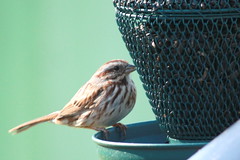Thought I would share this photo since I did squat today regarding the feeders and/or photography.
I did, however, learn a few things I will pass on. I will go into more detail in future postings.
- Your backyard setup need not be elaborate. I saw a few examples by some phenomenal photographers that have very simplistic setups. One, whom I very much respect, lives in a trailer park and shoots from his window!
The trick is setting up close enough to where you will do most of your shooting....around 15-20 feet or so. And, then, having a clean distance to your background....another 15-20 feet or so. That will blur out most of the distracting things most people don't know how to get rid of in their shots.
Personally, I rely on a tight crop of my photos to eliminate any distracting bokeh....like in the shot I posted. That lime green background is actually my rotten shed in my backyard. But, because I also shoot on a very low f/stop number, I have a very shallow depth of field (what's in focus). The rest of the out of focus stuff blurs out rather quickly, and here, rather smoothly.
I look to put in lots of photos of my birds in the coming months. But, with grass season kicking in, I will have a lot less time, too.
About the photo, though, this is a Song Sparrow. These are native birds to North America. The more common House Sparrow is NOT. He is an invader imported from England to take care of insects that were destroying crops in this new land. I will have to get on of my pics of the house sparrow for comaparison soon.
The song sparrow is (from AllAboutBirds.com): Size & Shape
Song Sparrows are medium-sized and fairly bulky sparrows. For a sparrow, the bill is short and stout and the head fairly rounded. The tail is long and rounded, and the wings are broad.
Color Pattern
Song Sparrows are streaky and brown with thick streaks on a white chest and flanks. On a closer look, the head is an attractive mix of warm red-brown and slaty gray, though these shades, as well as the amount of streaking, vary extensively across North America.
Behavior
Song Sparrows flit through dense, low vegetation or low branches, occasionally moving onto open ground after food. Flights are short and fluttering, with a characteristic downward pumping of the tail. Male Song Sparrows sing from exposed perches such as small trees.
Habitat
Look for Song Sparrows in nearly any open habitat, including marsh edges, overgrown fields, backyards, desert washes, and forest edges. Song Sparrows commonly visit bird feeders and build nests in residential areas.
I have had many house sparrows in my backyards, but have never seen a song sparrow before a week ago. It was a nice surprise to see him/her. And, he/she comes around every day. I assume it is paired up, too, because I saw another for the first time yesterday come along with this one.
I expected to see many common birds when I put seed out, but I am very interested to learn more about this guy as time goes on.
Another thing I will do, at the risk of running boringly long here, is to post the notes I have been keeping while observing my feeders. I try to take notes of what I see each day, and Katelyn helps, too.
For instance, I got to watch once today for about 15 minutes. Here is what I jotted down...
Thursday, April 1st, 2010...7am...Chickadee calling in a longer, more drawn out song than usual...mating call? Titmice eating in a pair, and together, every day now. Saw 2 Cardinals, both male, and neither saw the other....no chasing today....I think all the birds have paired up for mating...Saw a Grackle pair yesterday afternoon and I have Starlings now attempting to take over the House Sparrow nest site from last season.....although the House Sparrows are not giving up.....If the tree gets shared, it will be housing squirrels, sparrows (2), and starlings in it's cavities.
I am trying to get more detailed as I do more of this. But, it definitely helps. Taking notes is showing me what to expect when I have time to look.
Tomorrow, I plan to show you a piece of Juniper tree trunk I found today and plan to implement as a perch at some point.
Thursday, April 1, 2010
Subscribe to:
Post Comments (Atom)

No comments:
Post a Comment